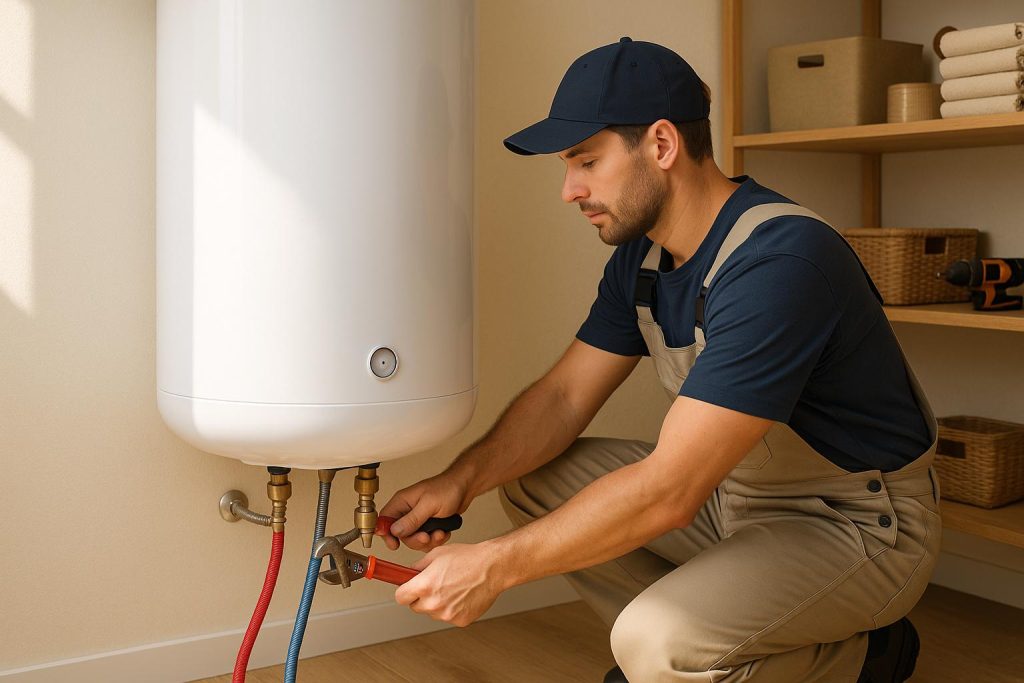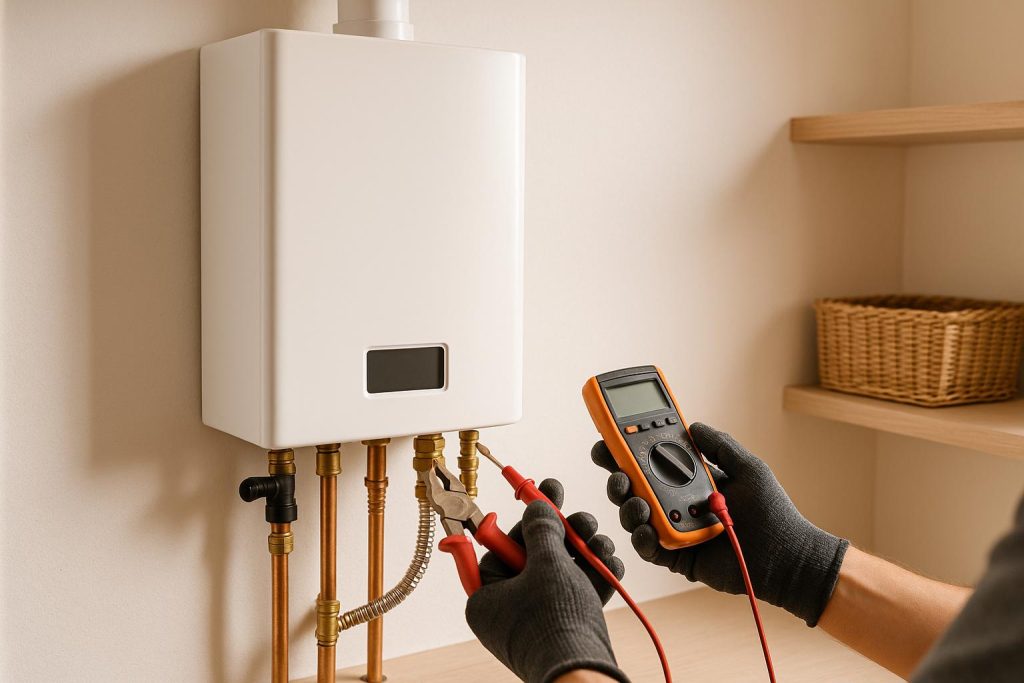Nearly 1 in 4 homeowners struggle with Low Water Pressure, making showers dribble, appliances underperform, and everyday chores a battle against trickles. If your faucets barely whisper and your morning routine feels like wading through molasses. Here’s what you need to know:
-
- Common causes: Clogged fixtures, leaks, mineral buildup in pipes, faulty pressure regulators, or municipal water supply issues.
- How to check pressure: Use a pressure gauge on an outdoor faucet. Ideal range: 40–60 psi.
- DIY fixes: Clean aerators and showerheads, check shutoff valves, or replace worn parts.
- When to call a pro: For persistent issues, pipe corrosion, or main water line problems.
How to Check Your Home Water Pressure
Test to see if your house has normal water pressure!
Why Low Water Pressure Matters
Low water pressure isn’t just inconvenient; it can damage appliances, inflate utility bills, and even lead to costly repairs over time. According to the U.S. Environmental Protection Agency (EPA), maintaining water pressure between 40–60 psi keeps fixtures operating efficiently and can save households up to 10% on annual water costs. Conversely, pressure below 30 psi affects roughly 25% of U.S. homes, often resulting in:
- Underperforming Appliances: Dishwashers and washing machines require at least 35 psi to complete cycles properly.
- Inefficient Cleaning: Low flow can leave soap scum in showers and prevent toilets from flushing fully.
- Longer Wait Times: Filling a standard bathtub can take 2–3 times longer, wasting both water and energy.
- Elevated Bills: Struggling appliances and extended run times can spike energy costs by up to 15% annually.
Before you swap out fixtures or call a pro, follow this guide to pinpoint the precise cause and tackle Low Water Pressure head‑on.
Top 3 Causes of Low Water Pressure
Identifying the root cause lets you apply the most effective solution, no guesswork required. Below are the three most common culprits, backed by industry data:
| Cause | % of Homes Affected | Impact |
| Mineral Buildup | 40% | Corrosion and scale in older pipes block flow, reducing psi by up to 25% over time. |
| Faulty Pressure Regulator | 30% | Pressure‑reducing valves (PRVs) fail or miscalibrate, dropping downstream pressure by 20–30%. |
| Municipal Supply Dips | 15% | Peak‑demand periods can lower neighborhood pressure by 10–15%, especially in high‑density areas. |
Fact: Homes built before 1980 with galvanized steel piping are twice as likely to experience mineral scaling, per a 2023 HomeAdvisor survey.
Quick Diagnosis Steps
A step‑by‑step check will tell you whether you’re facing a simple fixture issue or a whole‑house problem. Keep a notepad handy to record readings.
- Attach & Test
- Tool: Standard pressure gauge (with female hose threads).
- Method: Ensure every tap is off. Securely fasten the gauge to an outdoor hose bib closest to your main supply. Open fully and read the PSI.
- Pro Tip: If you see repeated fluctuations, let the gauge stabilize for 30 seconds before noting.
- Compare Flows
- Action: Test both hot and cold sides at one fixture. If only hot water is weak, the issue may lie in your water heater or hot‑water lines. If cold water is cold, the culprit is upstream.
- Inspect for Leaks: While testing, examine exposed pipes and fittings to Find Hidden Water Leaks; even small drips can signal systemic issues.
- Record & Analyze
- Ideal Range: 40–60 psi.
- Below 40 psi: True low pressure, move to DIY fixes.
- Above 80 psi: Excessive pressure, risk of burst pipes; consider installing or adjusting a PRV.
- Log Details: Date, time, psi reading, and which fixtures were tested. This log helps professionals diagnose recurring problems.
Top 3 DIY Fixes for Low Water Pressure
Once you know the cause, these targeted solutions can often restore your flow in under an hour, no plumber required.
Clean Aerators & P‑Traps
- Why: Aerators trap sediment and debris; P‑traps collect hair, soap scum, and minerals.
- How:
- Unscrew the aerator tip with pliers (wrap tape around jaws to avoid scratching).
- Rinse components under running water, then soak in white vinegar for 20 minutes.
- Scrub with an old toothbrush, reassemble, and test the flow.
- Follow our detailed guide on how to clean a P‑Trap for trap-specific maintenance.
- Time: 15–20 minutes per fixture.
- Expected Gain: Up to 10 psi boost if scaling was the issue.
Adjust or Replace Your PRV
- Why: PRVs regulate incoming pressure; a stuck valve can throttle your entire house.
- How:
- Locate the PRV near your water meter, usually a bell‑shaped device with an adjustment screw.
- Turn the screw clockwise to increase pressure (max recommended 75 psi).
- Recheck PSI after each quarter turn.
- If adjustment fails, replace the PRV (cost: $60–$120).
- Time: 30–45 minutes for adjustment; 1–2 hours for replacement.
- Expected Gain: Restore to manufacturer‑rated psi (often 50–70 psi).
Vinegar Soak for Showerheads
- Why: Showerheads accumulate mineral deposits that block spray nozzles.
- How:
- Fill a resealable bag with vinegar and secure it around the showerhead with a rubber band.
- Let soak for 1 hour.
- Remove the bag, run hot water for 2 minutes to flush.
- Wipe down the faceplate and test the pressure.
- Time: 1 hour soak + 5 minutes prep.
- Expected Gain: Noticeably stronger shower spray; up to 15% flow improvement.
Advanced Solutions & Equipment
If simple fixes don’t do the trick, these next‑level options can resolve tougher problems:
Install a Pressure Booster Pump
- Why: Ideal when municipal supply is persistently low or upper floors suffer.
- Cost: $300–$800 for the pump; $200–$400 for installation by a plumber.
- Benefit: Boosts pressure by 20–50 psi, customizable to your home’s needs.
Address Corroded or Galvanized Pipes
- Why: Old galvanized steel lines can corrode internally, reducing diameter by 50% or more.
- Solution:
- Replace with PEX or copper piping.
- Consider partial repiping of only the worst‑affected segments to save cost.
- Cost: $2,000–$5,000 for whole‑house repipe, depending on home size and accessibility.
Whole‑House Water Filtration Maintenance
- Why: Clogged filters in softeners or sediment systems can drop pressure by up to 30%.
- Routine: Replace filters every 3–6 months; flush system annually.
- Pro Tip: Use backflushable filters for easier upkeep.
When to Call a Professional
DIY work covers most fixes, but these warning signs mean it’s time to bring in a licensed plumber:
- Persistent PSI < 30: After cleaning and adjustments, any reading under 30 psi indicates deeper issues.
- Hidden Leaks & Widespread Corrosion: Unexplained wet spots, mold growth, or rusty water signal urgent pipe repair.
- Complex Repipe or PRV Replacement: Permits and code compliance often require professional credentials.
- Main Line Service & Municipal Coordination: If the problem traces back to the street line or meter, your plumber will coordinate with the utility.
Pro Insight: Licensed plumbers use camera‑inspection tools that can locate leaks within walls without demolition, saving time and money in the long run.
Tools & Resources You’ll Need
Stocking the right tools makes diagnoses faster and repairs more reliable:
| Tool | Purpose |
Est. Cost |
|
Pressure Gauge |
Measure incoming PSI | $15–$30 |
|
Adjustable Wrench |
Remove aerators, fittings |
$10–$25 |
|
White Vinegar & Toothbrush |
Dissolve and scrub mineral deposits |
$5 |
|
PRV Adjustment Screwdriver |
Fine‑tune or replace your pressure regulator |
$5–$10 |
|
Pipe Inspection Camera (rental) |
Locate hidden leaks |
$50/day |
For advanced equipment, consider rentals from local hardware stores or services like Home Depot Tool Rental.
Conclusion
Restoring your home’s Low Water Pressure is often faster and more affordable than you think. Start with a simple gauge test, apply targeted DIY fixes, and upgrade to advanced solutions only if necessary. Maintaining pressure between 40–60 psi not only delivers reliable performance but also protects your plumbing system and reduces utility costs by up to 10% annually.
FAQs
Q1: What’s the easiest way to test water pressure?
A1: Attach a pressure gauge to an outdoor spigot, ensure all taps are off, open fully, and read the psi. Ideal homes range from 40–60 psi.
Q2: Can a water softener affect pressure?
A2: Yes. Resin beads and filter cartridges can clog over time, dropping your flow by up to 20%. Regular backflushing or filter replacement prevents this.
Q3: How often should I check water pressure?
A3: Quarterly checks help you spot gradual declines before they become serious. Record readings to identify trends.
Q4: Is low water pressure covered by homeowner’s insurance?
A4: Typically not, unless caused by a sudden, accidental pipe burst. Routine wear and tear or fixture issues usually fall under maintenance.
Q5: What’s the lifespan of a PRV?
A5: Quality PRVs last 5–10 years before requiring recalibration or replacement. Plan to inspect yours during annual maintenance.






